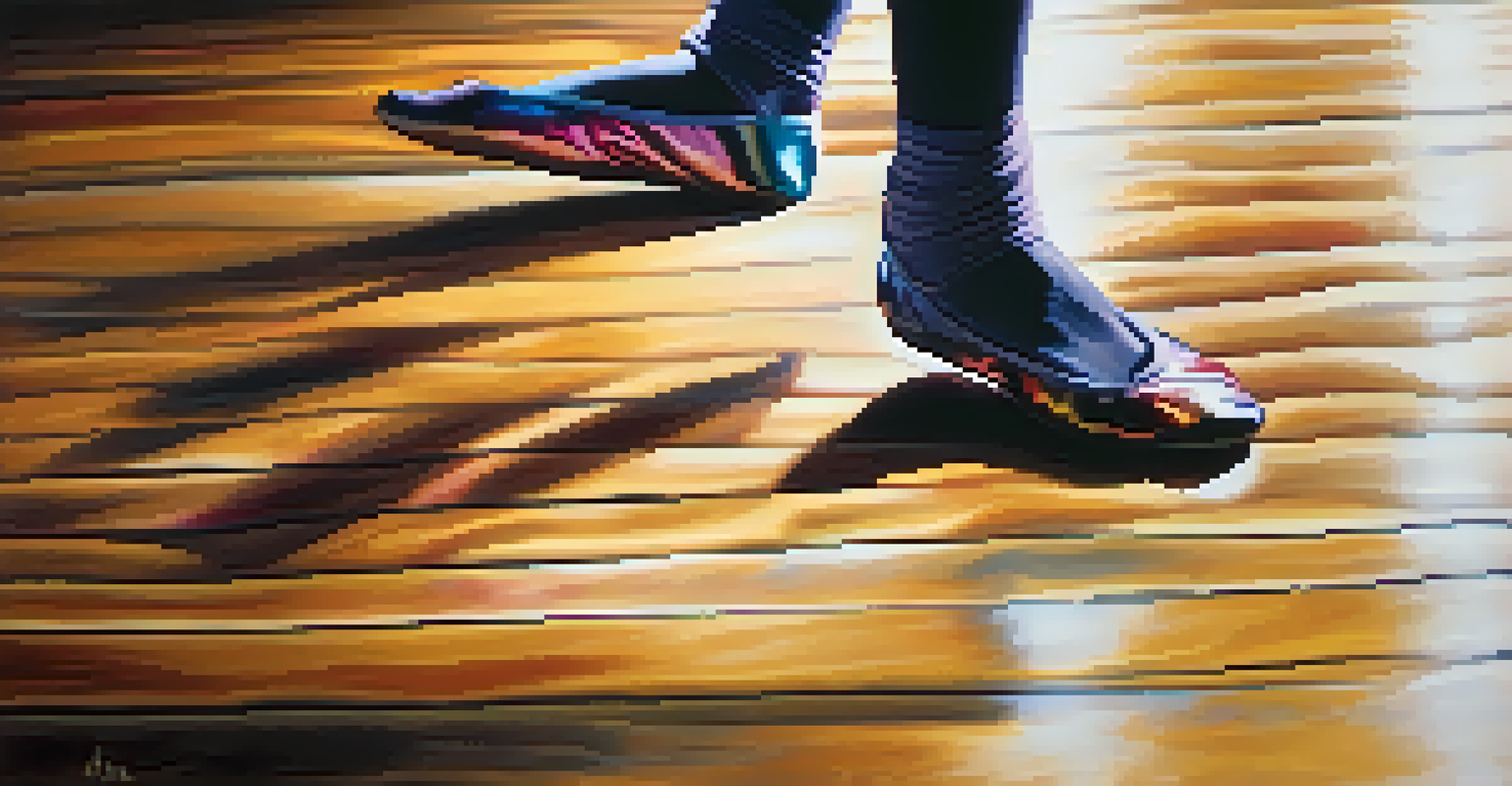The Impact of Dance on Self-Confidence and Individuality

Dance as a Tool for Building Self-Confidence
Dance is more than just movement; it’s a powerful medium for self-expression. When individuals engage in dance, they often experience a surge in self-confidence as they learn to embrace their bodies and express their emotions through movement. Each step, turn, and leap can help dancers push past their comfort zones, fostering a sense of accomplishment and self-assurance.
Dance is the hidden language of the soul.
For many, performing in front of an audience can be daunting, yet it often becomes a pivotal moment in building confidence. The adrenaline rush of dancing before others can transform into a feeling of empowerment, reinforcing the belief that they can overcome challenges. This newfound confidence can extend beyond the dance floor, influencing other areas of life, from social interactions to professional settings.
Moreover, dance classes often cultivate a supportive community where dancers cheer each other on. This camaraderie helps individuals realize they are not alone in their struggles, further bolstering their self-esteem. As dancers learn to appreciate their unique styles and expressions, their confidence continues to grow, enabling them to shine both inside and outside the studio.
Exploring Individuality Through Dance Styles
Every dance style tells a different story, allowing individuals to explore and express their unique identities. From ballet to hip-hop, each genre offers a distinct way for dancers to showcase their personalities. This freedom to choose a style that resonates with them fosters a sense of belonging and authenticity, celebrating what makes each person unique.

As dancers experiment with various styles, they often discover new aspects of themselves. For instance, someone who may feel shy might find their voice through the bold movements of street dance, while others may express their grace and elegance through contemporary ballet. This exploration is a journey of self-discovery, allowing dancers to connect with their inner selves and express their individuality.
Dance Boosts Self-Confidence
Engaging in dance fosters self-confidence as individuals embrace their bodies and express emotions through movement.
Furthermore, embracing individuality in dance can inspire others to do the same. When dancers confidently showcase their unique styles, it encourages peers to step out of their comfort zones as well. This ripple effect fosters a more inclusive environment where diversity is celebrated, ultimately enhancing the overall dance community.
Overcoming Insecurities Through Dance Practice
Many individuals struggle with insecurities, whether about their bodies, abilities, or self-worth. Dance provides a constructive outlet for addressing and overcoming these insecurities. As dancers practice regularly, they become more attuned to their bodies, learning to appreciate their unique shapes and strengths, rather than focusing on perceived flaws.
To dance is to be out of yourself. Larger, more beautiful, more powerful. You are in the world of a dance.
The repetitive nature of dance practice also plays a significant role in building resilience. As dancers strive to master new moves and routines, they encounter failures and successes alike. Each misstep becomes a learning opportunity, reinforcing the idea that growth comes from perseverance. This shift in mindset helps dancers tackle insecurities head-on, transforming them into sources of motivation.
Moreover, the journey of mastering a dance piece can instill a sense of pride and accomplishment. When dancers finally perform a routine they once found challenging, it serves as a powerful reminder that they can overcome obstacles. This sense of achievement not only boosts their self-confidence but also encourages them to face other life challenges with the same tenacity.
The Social Benefits of Dancing for Confidence
Participating in dance can significantly enhance social skills, which in turn boosts self-confidence. Dance classes and social dance events provide a platform for individuals to interact and build connections with others who share similar interests. This social aspect of dance encourages participants to engage, communicate, and collaborate, fostering a sense of community.
In these supportive environments, dancers can practice their social skills without the pressure often found in other settings. They learn to navigate conversations, connect with peers, and even make new friends—all while enjoying the rhythm of the music. As social interactions become more comfortable, individuals often find that their self-esteem flourishes.
Individuality Through Dance Styles
Exploring various dance styles allows individuals to express their unique identities and fosters a sense of belonging.
Furthermore, dancing together in groups or pairs can create a sense of belonging. When dancers support one another, it reduces feelings of isolation and enhances emotional well-being. This supportive network encourages individuals to embrace their true selves, leading to a richer, more confident experience both on and off the dance floor.
Dance as a Form of Emotional Expression
Dance serves as a powerful medium for emotional expression, allowing individuals to convey feelings they may struggle to articulate with words. Whether it’s joy, sadness, anger, or love, the movements and rhythms of dance can capture the essence of human emotion. This form of expression can be incredibly liberating, helping individuals feel more in tune with themselves.
When dancers connect with their emotions through movement, they often experience a sense of catharsis. It’s not uncommon for someone to feel lighter or more liberated after a dance session, as if they’ve released pent-up feelings. This emotional release can significantly enhance self-awareness and lead to greater self-acceptance, further bolstering self-confidence.
Moreover, sharing these emotional experiences with an audience or fellow dancers can deepen connections. When performers convey genuine feelings through their dance, they resonate with others on a personal level, fostering empathy and understanding. This shared emotional journey not only uplifts individual dancers but also strengthens the bonds within the dance community.
The Role of Dance in Personal Development
Engaging in dance goes beyond physical movement; it plays a crucial role in personal development. Through dance, individuals learn discipline, commitment, and goal-setting, which are essential traits for success in various aspects of life. The dedication to practice and improvement fosters a strong sense of responsibility and work ethic.
As dancers set and achieve goals—like mastering a routine or performing in front of an audience—they build self-confidence and belief in their abilities. This sense of achievement encourages them to pursue other goals, both in dance and beyond. The skills cultivated through dance can translate to academic and professional success, empowering individuals to chase their dreams.
Dance Enhances Social Skills
Participating in dance creates opportunities for social interaction, helping individuals build connections and improve self-esteem.
Additionally, the process of learning and growing in dance encourages a growth mindset. Dancers learn to embrace challenges, view failures as stepping stones, and celebrate their progress. This perspective not only enhances their dance journey but also equips them with life skills, making them more resilient and confident individuals in the face of life’s hurdles.
Conclusion: Dance as a Catalyst for Confidence and Individuality
In conclusion, dance is a multifaceted art form that profoundly impacts self-confidence and individuality. Through expressive movement, individuals can explore their emotions, overcome insecurities, and develop a strong sense of self. The supportive dance community further nurtures these qualities, fostering an environment where uniqueness is celebrated.
As dancers continue their journey, they not only gain confidence in their abilities but also in who they are as individuals. The lessons learned on the dance floor—such as resilience, self-expression, and connection—extend far beyond the studio, influencing every aspect of their lives. Dance becomes a powerful vehicle for personal growth and empowerment.

Ultimately, embracing dance can lead to a more confident, authentic self. So whether you're a seasoned dancer or just starting, remember that every step you take is a step toward discovering and celebrating your unique journey.